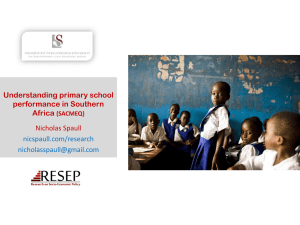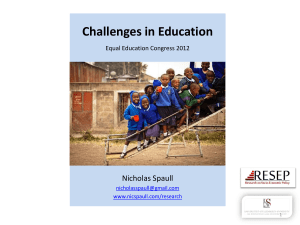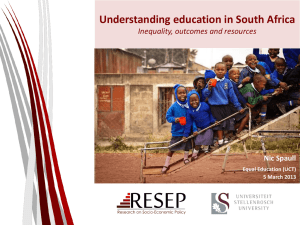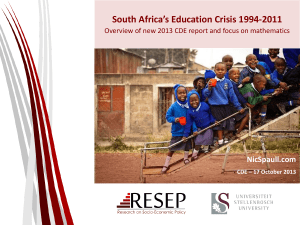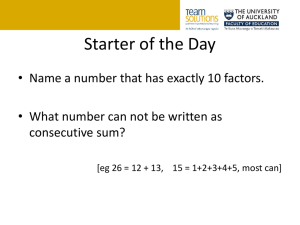Education Report Card 1996-2011: An Ailing System
advertisement
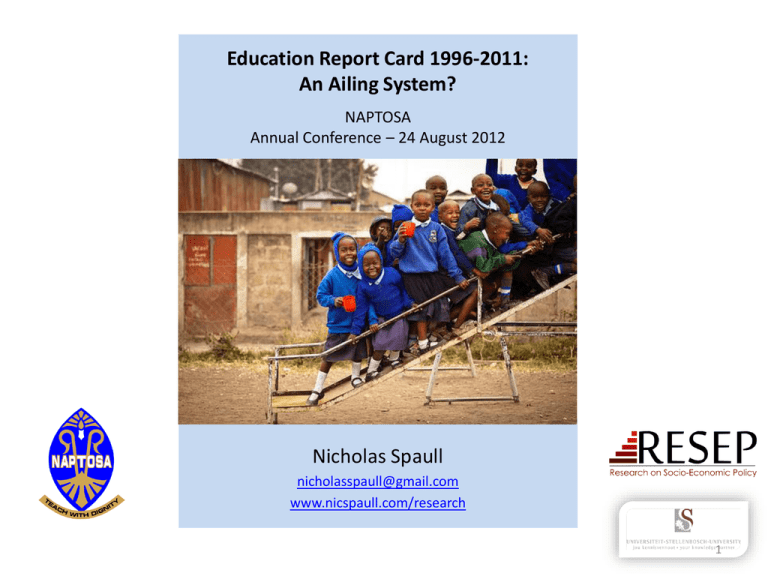
Education Report Card 1996-2011: An Ailing System? NAPTOSA Annual Conference – 24 August 2012 Nicholas Spaull nicholasspaull@gmail.com www.nicspaull.com/research 1 Outline 1) Spending on education (1994-2011) – – Provincial spending on education Overall spending on education 2) Access to education 3) Quality: South African student performance (2003-2011) – Locally and internationally – Teacher knowledge and student knowledge – Teacher absenteeism in context 4) Conclusion 2 Spending 1994 Per Learner Budget Allocations, by Province 1994-95 4500 4000 3500 ECA LMP 3000 NWP MPU 2500 FST KZN 2000 NCA 1500 GAU WC 1000 All 500 0 ECA LMP NWP MPU FST KZN NCA GAU WC All (Fiske & Ladd, 2004: 104) 3 Spending 2000 Per Learner Budget Allocations, by Province 2000-01 5000 4500 4000 ECA 3500 LMP NWP 3000 MPU FST 2500 KZN 2000 NCA GAU 1500 WC 1000 All 500 0 ECA LMP NWP MPU FST KZN NCA GAU WC All (Fiske & Ladd, 2004: 104) 4 Spending 2000-2011 Spending on public ordinary schools per public school per learner by province in 2001/2 and 2010/11 12,000 10,074 9,836 10,250 10,482 10,000 8,000 6,000 4,000 2,000 2001/02 2005/06 2010/11 - (Oxford Policy Management & Stellenbosch Economics, 2012) 5 Spending Spending by education departments, real (2005) Rand 2000/01 to 2010/11 120.0 100.0 OSD R billion 80.0 60.0 40.0 National education spending Provincial education spending TOTAL Departmental Spending 20.0 .0 (Oxford Policy Management & Stellenbosch Economics, 2012) 6 Expenditure on education 2010/11 Total government expenditure Government exp on education (31% GDP in 2010/11 – R733.5bn) (19.5% of Gov exp: R143.1bn) 17% 5% Other Government spending 80.50% Education: Other current 19.50% 78% Education: Capital Education: Personnel 7 Expenditure Post-apartheid government has equalised government expenditures across provinces and has adopted pro-poor public spending 8 Access • Percentage of learners enrolled in grade 1 who attended a pre-primary programme increased from 61% in 2006 to 71% in 2009 • At least 99% of children enter formal schooling and only a few drop out in primary school. • In the last ten years the proportion of youths attaining grade 9 has risen from 76% to 86%. 9 Access Post-apartheid government has expanded the education system with almost universal coverage in the primary and early secondary grades. 10 Quality of education: outcomes • What are the educational outcomes in SA? • What do South African students know? – Compared to local standards? – Compared to other countries? 11 Matric performance Matric performance • • • Matric passes as % of Gr 2 learners 10 years earlier: – 2009: 28% – 2010: 34% – 2011: 38% In the bottom 4 quintiles of schools, only 1% of learners in grade 8 will go on to pass matric and obtain a C symbol or higher (60%) for Mathematics and slightly fewer for Physical Science Approximately ten times as many will do so in Quintile 5 schools Flow through: learner numbers in grades 2, 10 and 12 and matric passes 1,400,000 1,200,000 1,000,000 800,000 600,000 400,000 200,000 0 2009 2010 2011 Gr.2 (10 years prior) Gr.10 (2 years prior) Numbers who wrote matric Number who passed matric (Oxford Policy Management & Stellenbosch Economics, 2012) 13 Source of the problem? • • • • Matric is the only externally-evaluated standardised exam High and lenient grade progression High drop out in grades 10, 11 and 12 “Low quality education combined with high and lenient grade progression up until grade 11 means that when a standardised assessment occurs, i.e. the Matric examination, this serves to filter a large proportion of weak students out of further attainment…Therefore, low-quality education up until grade 11 can be regarded as the root cause of low attainment beyond grade 11.” (Van der Berg et al, 2011: 4) • i.e. the REAL problem is at the primary grades • Focus on primary school 14 Student performance 2003-2011 TIMSS (2003) PIRLS (2006) SACMEQ (2007) ANA (2011) TIMSS 2003 (Gr8 Maths & Science) PIRLS 2006 (Gr 4/5 – Reading) • Out of 50 participating countries (including 6 • Out of 45 participating countries African countries) SA came last SA came last SACMEQ III 2007 (Gr6 – Reading & behind Botswana and Morocco • Only 10% reached low international benchmark 87% of gr4 and 78% ofTIMSS Gr 5 learners deemed to be •• No improvement from 1999-TIMSS 2003 Maths) “at serious risk of not learning to read” • SA came 10/15 for reading and 8/15 for maths ANA 2011 (Gr 1-6 Reading & Maths) behind countries such as Swaziland, Kenya and Tanzania • • • • Mean literacy score gr3: 35% Mean numeracy score gr3: 28% Mean literacy score gr6: 28% Mean numeracy score gr6: 30% 15 Background: SACMEQ SACMEQ Southern and Eastern African Consortium for Monitoring Educational Quality o Gr 6 Numeracy o Gr 6 Literacy SACMEQ: South Africa 2007 9071 Grade 6 students 1163 Grade 6 teachers 392 primary schools • See SACMEQ website for research 16 Basic Literacy and Numeracy (Gr 6) • What proportion of South African grade 6 children were functionally literate and functionally numerate? • Functionally illiterate: a functionally illiterate learner cannot read a short and simple text and extract meaning. • Functionally innumerate: a functionally innumerate learner cannot translate graphical information into fractions or interpret everyday units of measurement. 17 SA primary school: Gr6 Literacy – SACMEQ III (2007) Never enrolled 2% Functionally illiterate 25% Basic skills 46% Higher order skills : 27% 18 Grade 6 Literacy SA Gr 6 Literacy 2% 25% illiterate Kenya Gr 6 Literacy 5% 7% illiterate 49% 46% Public current expenditure 27% per pupil: $1225 Additional resources is not the answer 39% Public current expenditure per pupil: $258 19 Grade 6 Literacy Grade 6 aged population that are functionally literate (SACMEQ III) 100 $668 90 $66 80 $1225 70 71 71 Lesotho Uganda South Africa 80 $258 $459 87 88 Kenya Swaziland 82 75 70 60 50 54 49 40 30 20 10 0 Zambia Malawi Zimbabwe Namibia Tanzania 20 Labour Market University/ FET • High productivity jobs and incomes (10%) 10% • • • High quality secondary school Type of institution (FET or University) Quality of institution Type of qualification (diploma, degree etc.) Field of study (Engineering, Arts etc.) High SES background High quality primary school Minority (20%) Unequal society Majority (80%) Low productivity jobs & incomes Low productivity jobs & incomes Low quality secondary school Low SES background (55%) Low quality primary school Unemployed (35%) 21 (Taylor, 2011) .01 0 • .005 • Grade 4 [2008] • Data: NSES Density Ex-department .015 .02 .025 Two school systems not one 0 20 40 60 Numeracy score 2008 Ex-DET/Homelands schools 80 100 Historically white schools 22 • (Shepherd, 2011) .004 .003 0 • Grade 5 [2006] • Data: PIRLS .002 Language .001 kdensity reading test score .005 Two school systems not one 0 200 400 reading test score African language schools 600 800 English/Afrikaans schools 23 • (Spaull, 2011) 0 • Grade 6 [2007] • Data: SACMEQ .002 Density Socioeconomic Status .004 .006 .008 Two school systems not one 0 200 400 600 Learner Reading Score Poorest 25% Second wealthiest 25% 800 1000 Second poorest 25% Wealthiest 25% Abstract… 24 Grade 3 Numeracy (V-ANA 2011) Correct answer (15cm): 40% of Gr 3 students Verification ANA Gr3 Numeracy (Quest 18) Quintile 1 2 3 4 5 Total Wrong 63% 68% 63% 57% 42% 60% Right 37% 32% 37% 43% 58% 40% Total 100% 100% 100% 100% 100% 100% NB: Test conducted in home language LOLT 25 Grade 6 Numeracy (V-ANA 2011) Correct answer (90 litres): 32% of Gr 6 students Verification ANA 2011 Gr6 Numeracy (Quest 25.1) Quintile 1 2 3 4 5 Total Wrong 74% 75% 70% 68% 50% 68% Right 26% 25% 30% 32% 50% Total 100% 100% 100% 100% 100% 32% 26 100% Determinants of low quality? What are some of the determinants of the low quality education in South Africa? • What do South African teachers know? • Teacher content knowledge • What are the levels of teacher absenteeism? • Time on task and curriculum coverage 27 Teacher knowledge SACMEQ III (2007) 401/498 Gr6 Mathematics teachers 7 Correct answer (7km): 38% of Gr 6 Maths teachers SACMEQ Maths teacher test Q17 Correct 1 23% 2 22% Quintile 3 38% 4 40% 5 74% Avg 38% 2 education systems 28 Teacher knowledge... Maths teacher content knowledge (SACMEQ III) Source: Stephen Taylor 29 Accountability: teacher absenteeism (SACMEQ III – 2007 – 996 teachers) Non-strike teacher absenteeism SACMEQ III (2007) 25 20 4th/15 15 Days per year 10 19 5 6 7 8 8 9 9 10 10 11 11 12 14 14 14 0 30 Accountability: teacher absenteeism (SACMEQ III – 2007 – 996 teachers) Non-strike Self-reported teacher absenteeism (days) SACMEQ III (2007) Non-strike teacher absenteeism Teachers' strikes 25 15th/15 20 0 15 12 0 Days per year 2 10 0 0 5 7 0 0 8 8 9 9 10 10 0 0 0 19 0 0 6 0 0 11 11 12 14 14 14 0 31 Accountability: teacher absenteeism • Teacher absenteeism is regularly found to be an issue in many studies in SA • 2007: SACMEQ III conducted – 20 days average in 2007 • 2008: Khulisa Consortium audit – HSRC (2010) estimates that 20-24 days of regular instructional time were lost due to leave in 2008 • 2010: “An estimated 20 teaching days per teacher were lost during the 2010 teachers’ strike” (DBE, 2011: 18) • Importantly this does not include time lost where teachers were at school but not teaching scheduled lessons • A recent study observing 58 schools in the North West concluded that “Teachers did not teach 60% of the lessons they were scheduled to teach in North West” (Carnoy & Chisholm et al, 2012) 32 Accountability: teacher absenteeism (SACMEQ III – 2007 – 996 teachers) Western Cape Eastern Cape Limpopo KwaZulu-Natal % absent > 1 week striking 32% 81% 97% 82% % absent > 1 month (20 days) 22% 62% 48% 73% % absent > 2 months (40 days) 5% 12% 0% 10% 1.3 days a week 33 2 education systems Dysfunctional Schools (75% of schools) Functional Schools (25% of schools) Weak accountability Strong accountability Incompetent school management Good school management Lack of culture of learning, discipline and order Culture of learning, discipline and order Inadequate LTSM Adequate LTSM Weak teacher content knowledge Adequate teacher content knowledge High teacher absenteeism (1 month/yr) Low teacher absenteeism (2 week/yr) Slow curriculum coverage, little homework or testing Covers the curriculum, weekly homework, frequent testing High repetition & dropout (Gr10-12) Low repetition & dropout (Gr10-12) Extremely weak learning: most students fail standardised tests Adequate learner performance (primary and matric) 34 Quality Quality of education and educational outcomes are very low and highly unequal 35 2 Significant recent improvements (2010/11) 1. Annual National Assessments – – – – 2 main aims are (1) accountability, and (2) support Provide comparable information on student learning & school performance & provides benchmarks for assessment Support can be targeted to specific schools, teachers and learners NB: Needs to be externally evaluated (Umalusi?) at at least one primary grade 2. Workbooks – – – – A workbook for every child for maths and language High quality learning/teaching resources Helps teacher pace learning & cover curriculum 4 worksheets/term ; 8 weeks/term ; 2 terms per volume (4 workbooks per year – 2 for maths and 2 for language 36 State of SA education since transition…consensus? “Although 99.7% of South African children are in school…the outcomes in education are abysmal” (Manuel, 2011) “Without ambiguity or the possibility of misinterpretation, the pieces together reveal the predicament of South African primary education” (Fleisch, 2008: 2) “Our researchers found that what students know and can do is dismal” (Taylor & Vinjevold, 1999) “It is not an overstatement to say that South African education is in crisis.” (Van der Berg & Spaull, 2011) 37 Scorecard • Equalize expenditure • Expand access • Improve quality/outcomes 38 Verdict? The post-apartheid government inherited a divided and mostly dysfunctional education system. While it has successfully managed to increase access, equalize government expenditures and ensure that government spending is pro-poor, on the most important task of providing all children with a basic education, irrespective of race, class or geography, it has failed dysmally. It is unfortunate but true that the current educational system lacks the ability to educate most of the youth in South Africa. Most of South Africa’s primary schools perform worse than poorer schools in poorer African countries. It is without question that the majority of South Africa’s schooling system remains dysfunctional in that it lacks the ability to educate most of the youth in South Africa. Every survey that we have testifies to this fact. Children may be in school, but most are simply not learning what they should be. 39 Conclusions 1. Some important successes (access, spending, and recently, ANA workbooks and CAPS) 2. Two education systems not one. Quality of education in most SA schools is far too low – this cannot continue without social consequences 3. 4. Low quality education Equalizing resources has not equalized outcomes – need accountability Most of South Africa performs worse than many poorer African countries – more resources is not the answer 5. SA has the highest teacher absenteeism in 14 African countries 6. Failure to get the basics right – large numbers of students (30%) are failing to acquire BASIC numeracy and literacy skills Low social mobility Hereditary poverty 40 Education “Education is the great engine of personal development. It is through education that the daughter of a peasant can become a doctor, that the son of a mineworker can become the head of the mine, that a child of farmworkers can become the president” – Nelson Mandela If we looked at 200 black Grade 1 children 12 years ago and then look at them again in matric, only 1 out of the 200 (<1%) were eligible for a maths or science degree based on their matric marks – the correspodning figure for white children was 15 times higher. *based on 2007 matric cohort statistics 41 References • • • • • • • • • • Fleisch, B. (2008). Primary Education in Crisis: Why South African schoolchildren underachieve in reading and mathematics. Cape Town. : Juta & Co. Hoadley, U. (2010). What doe we know about teaching and learning in primary schools in South Africa? A review of the classroombased research literature. Report for the Grade 3 Improvement project of the University of Stellenbosch. Western Cape Education Department. Hungi, N., Makuwa, D., Ross, K., Saito, M., Dolata, S., van Capelle, F., et al. (2011). SACMEQ III Project Results: Levels and Trends in School Resources among SACMEQ School Systems. Paris: Southern and Eastern Africa Consortium for Monitoring Educational Quality. Ross, K., Saito, M., Dolata, S., Ikeda, M., Zuze, L., Murimba, S., et al. (2005). The Conduct of the SACMEQ III Project. In E. Onsomu, J. Nzomo, & C. Obiero, The SACMEQ II Project in Kenya: A Study of the Conditions of Schooling and the Quality of Education. Harare: SACMEQ. Shepherd, D. (2011). Constraints to School Effectiveness: What prevents poor schools from delivering results? Stellenbosch Economic Working Papers 05/11. [PIRLS] Spaull, N. (2011a). A Preliminary Analysis of SACMEQ III South Africa.Stellenbosch Economic Working Papers. Spaull, N. (2011). Primary School Performance in Botswana, Mozambique, Namibia and South Africa. Paris: Southern and Eastern African Consortium for Monitoring Educational Quality (SACMEQ) Working Paper no.8. Spaull, N. 2012 Equity & Efficiency in South African primary schools : a preliminary analysis of SACMEQ III South Africa Masters Thesis. Economics. Stellenbosch University Taylor, S. (2011). Uncovering indicators of effective school management in South Africa using the National School Effectiveness Study.Stellenbosch Economic Working Papers 10/11, 1-51. [NSES] Van der Berg, S., Burger, C., Burger, R., de Vos, M., du Rand, G., Gustafsson, M., Shepherd, D., Spaull, N., Taylor, S., van Broekhuizen, H., and von Fintel, D. (2011). Low quality education as a poverty trap. Stellenbosch: University of Stellenbosch, Department of Economics. Research report for the PSPPD project for Presidency. 42 Thank you www.nicspaull.com/research nicholasspaull@gmail.com @NicSpaull 43 3 biggest challenges - SA 1.Failure to get the basics right • • Children who cannot read, write and compute properly (Functionally illiterate/innumerate) after 6 years of formal full-time schooling Often teachers lack even the most basic knowledge 2.Equity in education • • 2 education systems – dysfunctional system operates at bottom of African countries, functional system operates at bottom of developed countries. More resources is NOT the silver bullet – we are not using existing resources 3.Lack of accountability • • • Little accountability to parents in majority of school system Little accountability between teachers and Department Most teacher unions focus almost exclusively on wage negotatiations with little emphasis on professional development & improving quality 44 Way forward? 1. Acknowledge the extent of the problem • Low quality education is one of the three largest crises facing our country (along with HIV/AIDS and unemployment). Need the political will and public support for widespread reform. 2. Focus on the basics • • • • • Every child MUST master the basics of foundational numeracy and literacy these are the building blocks of further education – weak foundations = recipe for disaster Teachers need to be in school teaching (re-introduce inspectorate?) Every teacher needs a minimum competency (basic) in the subjects they teach Every child (teacher) needs access to adequate learning (teaching) materials Use every school day and every school period – maximise instructional time 3. Increase information, accountability & transparency • • • At ALL levels – DBE, district, school, classroom, learner Strengthen ANA Set realistic goals for improvement and hold people accountable 45 Teaching Characterised by: • • • • Type Labour Market High productivity jobs and incomes (10%) Mainly professional, managerial & skilled jobs Requires graduates, good quality matric or good vocational skills Historically mainly white • • • • • • • • 10% • Often manual or low skill jobs Limited or low quality education Minimum wage can exceed productivity Strong accountability Well managed & organized Good school discipline Culture of L & T High quality secondary school Type of institution (FET or University) Quality of institution Type of qualification (diploma, degree etc.) Field of study (Engineering, Arts etc.) High SES background High quality primary school Some motivated, lucky or talented students make the transition Vocational training Affirmative action Low productivity jobs & incomes • University/ FET - Low productivity jobs & incomes Quality • Minority (20%) Big demand for good schools despite fees Some scholarships/bursaries Unequal society Majority (80%) Low quality secondary school Low SES background (55%) Low quality primary school Unemployed (35%) Attainment • Schools Characterised by: • • • • High cognitive demand Full curriculum coverage Adequate LTSM Frequent assessment Teaching Characterised by: • • • • • Low cognitive demand Slow curriculum coverage Inadequate LTSM Weak & infrequent assessment Weak teacher content knowledge Schools Characterised by: • • • • • Little parental involvement No accountability Little discipline 46 Weak management High teacher absenteeism 47 Accountability: teacher absenteeism (SACMEQ III – 2007 – 996 teachers) Total teacher abseteeism (days) Percentage Percentage Teacher absent for > 1 absent for > 1 strikes only week due to month due to (days) strikes strikes Percentage absent > 1 month Percentage absent > 2 month Percentage absent > 3 month ECA 22 14 81% 0% 62% 12% 9% FST 17 9 62% 3% 25% 7% 2% GTN 12 6 41% 0% 16% 3% 3% KZN 26 15 82% 56% 73% 10% 5% LMP 21 14 97% 0% 48% 0% 0% MPU 24 13 87% 9% 48% 6% 4% NCA 18 11 62% 32% 50% 2% 0% NWP 19 10 73% 8% 45% 11% 8% WCA 11 5 32% 12% 22% 5% 2% Total 20 12 71% 24% 47% 7% 4% 48 Description of Range on 500 levels point scale Level 1 Pre-reading < 373 Skills Level 2 Emergent reading Matches words and pictures involving prepositions and abstract concepts; uses cuing systems (by sounding out, using simple sentence structure, and familiar words) to interpret phrases by reading on. 373 414 [1] Level 3 Basic reading Level 4 Reading for meaning Level 5 Interpretive reading Level 6 Inferential reading Level 7 Analytical reading Matches words and pictures involving concrete concepts and everyday objects. Follows short simple written instructions. See Ross et al. (2005, p. 95). 414 457 Interprets meaning (by matching words and phrases, completing a sentence, or matching adjacent words) in a short and simple text by reading on or reading back. 457 509 Reads on or reads back in order to link and interpret information located in various parts of the text. 509 563 Reads on and reads back in order to combine and interpret information from various parts of the text in association with external information (based on recalled factual knowledge) that “completes” and contextualizes meaning. 563 618 Reads on and reads back through longer texts (narrative, document or expository) in order to combine information from various parts of the text so as to infer the writer’s purpose. 618 703 Locates information in longer texts (narrative, document or expository) by reading on and reading back in order to combine information from various parts of the text so as to infer the writer’s personal beliefs (value systems, prejudices, and/or biases). Level 8 Critical reading 703+ Locates information in a longer texts (narrative, document or expository) by reading on and reading back in order to combine information from various parts of the text so as to infer and evaluate what the writer has assumed about both the topic and the characteristics of the reader – such as age, knowledge, and personal beliefs (value systems, prejudices, and/or biases). 49 Description of levels Range on 500 point scale Level 1 Pre-numeracy Level 2 Emergent numeracy [1] < 364 Applies single step addition or subtraction operations. Recognizes simple shapes. Matches numbers and pictures. Counts in whole numbers. 364 462 Applies a two-step addition or subtraction operation involving carrying, checking (through very basic estimation), or conversion of pictures to numbers. Estimates the length of familiar objects. Recognizes common two-dimensional shapes. See (Ross, et al., 2005, p. 95). Level 3 Basic numeracy 462 532 Level 4 Beginning numeracy 532 587 Level 5 Competent numeracy 587 644 Level 6 Mathematically skilled Level 7 Concrete solving Level 8 Abstract solving Skills 644 720 problem 720 806 problem > 806 Translates verbal information presented in a sentence, simple graph or table using one arithmetic operation in several repeated steps. Translates graphical information into fractions. Interprets place value of whole numbers up to thousands. Interprets simple common everyday units of measurement. Translates verbal or graphic information into simple arithmetic problems. Uses multiple different arithmetic operations (in the correct order) on whole numbers, fractions, and/or decimals. Translates verbal, graphic, or tabular information into an arithmetic form in order to solve a given problem. Solves multiple-operation problems (using the correct order of arithmetic operations) involving everyday units of measurement and/or whole and mixed numbers. Converts basic measurement units from one level of measurement to another (for example, metres to centimetres). Solves multiple-operation problems (using the correct order of arithmetic operations) involving fractions, ratios, and decimals. Translates verbal and graphic representation information into symbolic, algebraic, and equation form in order to solve a given mathematical problem. Checks and estimates answers using external knowledge (not provided within the problem). Extracts and converts (for example, with respect to measurement units) information from tables, charts, visual and symbolic presentations in order to identify, and then solves multi-step problems. Identifies the nature of an unstated mathematical problem embedded within verbal or graphic information, and then translate this into symbolic, algebraic, or equation form in 50 order to solve the problem. Source: (Hungi, et al., 2010) 51 Public Current expenditure on Country Total population Adult literacy (mil) rate Net Enrolment Rate (2008) GNP/cap PPP primary education per pupil (unit US$ (2008) cost) 2007 – [PPP constant 2006 US$] Survival rate to Grade 5: school year ending 2007 Botswana 1.92 83% 87% 13100 1228 89%3 Mozambique 22.38 54% 80% 770 792 60% Namibia 2.13 88% 89% 6270 668 87%3 South Africa 49.67 89% 87% 9780 1225 98% (UNESCO, 2011) (UNESCO, 2011) (UNESCO, 2011) (UNESCO, 2011) (UIS, 2009) (UNESCO, 2011) Source SACMEQ III (2007) Self-reported teacher absenteeism Proportion of Grade 6 students functionally illiterate Proportion of Grade 6 students functionally innumerate Proportion of students Proportion of students with own reading with own mathematics textbook textbook Botswana 10.6 days 10.62% 22.48% 63% 62% Mozambique 6.4 days 21.51% 32.73% 53% 52% Namibia 9.4 days 13.63% 47.69% 32% 32% South Africa 19.4 days 27.26% 40.17% 45% 36% 52 53 Teacher knowledge... Q6: 53% correct (D) Q9: 24% correct (C) English Q9: 57% correct (D) 54 Passing relative to cohort (2008) 70% 60% 50% 40% Pass Matric 30% Maths passes 20% Endorsements 10% HG Maths passes 0% Blacks Coloureds Indians Whites Total A-aggregates 55
